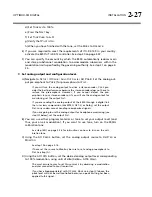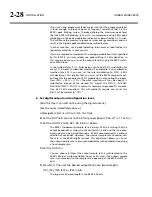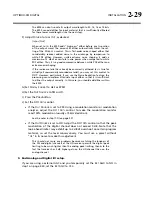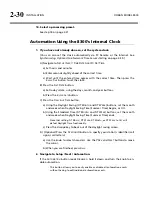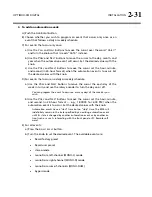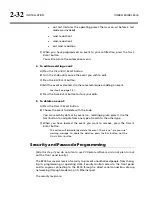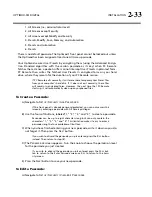
2-18
INSTALLATION
ORBAN MODEL 8300
below threshold. It is not designed to perform an AGC or gain-riding
function, and it cannot substitute for the AGC function in the 8300.
8.
Select your primary input (analog or digital).
A)
Press the
N
EXT
button.
B)
If your main input source is digital, turn the knob to select
D
IGITAL
or
D
IGITAL
+J17
. Otherwise, select
A
NALOG
.
The only digital encoding that typically uses J.17 pre-emphasis (of which
we are aware) is NICAM.
D
IGITAL
, not
D
IGITAL
+J17,
is appropriate for al-
most anyone using the digital input
.
9.
Set operating levels.
You will set the operating levels of the 8300 to match the input levels it is receiv-
ing so the 8300’s AGC can operate in the range for which it was designed. There
are separate settings for the analog and digital inputs. If you provide both ana-
log and digital inputs to the 8300, optimum adjustment is achieved when the
gain reduction meters show the same amount of processing for both analog and
digital inputs.
This will allow you to switch between analog and digital inputs without
sudden level changes.
A)
Press the
N
EXT
button.
B)
Feed normal program material to the 8300.
C)
Play program material from your studio, peaking at normal program levels
(typically 0VU if your console uses VU meters).
D)
[Skip this step if you are not using the analog input.]
Hold down the
A
NALOG
soft button and adjust the knob so that the
AGC
meter indicates an average of 10 dB gain reduction.
E)
[Skip this step if you are not using the digital input.]
Hold down the
D
IGITAL
soft button and adjust the knob so that the
AGC
meter indicates an average of 10 dB gain reduction.
10.
Set the analog output source.
If you do not need the 8300’s analog output to drive a transmitter, you can con-
figure it to receive the output of a special low-delay version of the multiband
compressor. This signal is suited for driving headphones. The input/output delay
is approximately five milliseconds. Even though normal 8300 presets have a delay
of about 15 ms (which most DJs, announcers, and presenters can learn to use
without discomfort, although they may need some time to become accustomed
to it), the low-delay output will cause less bone conduction comb filtering. How-
ever, in most cases, the low-delay output will not be necessary to ensure ade-
quate talent comfort.
The 8300 offers several low-latency (“UL”) presets having 5 ms delay and
the ability to drive a transmitter. However, the audio performance of
Summary of Contents for 8300J
Page 1: ...Operating Manual OPTIMOD FM 8300 Digital Audio Processor Version 2 1 Software...
Page 7: ...Operating Manual OPTIMOD FM 8300 Digital Audio Processor Version 2 1 Software...
Page 24: ......
Page 94: ...2 46 INSTALLATION ORBAN MODEL 8300 This page intentionally left blank...
Page 190: ......
Page 204: ......
Page 246: ......
Page 247: ...OPTIMOD FM DIGITAL TECHNICAL DATA 6 29...
Page 254: ...6 36 TECHNICAL DATA ORBAN MODEL 8300 CPU Module...
Page 260: ...6 42 TECHNICAL DATA ORBAN MODEL 8300 8300 RS232 BOARD PARTS LOCATOR...
Page 262: ...6 44 TECHNICAL DATA ORBAN MODEL 8300 8300 POWER SUPPLY PARTS LOCATOR...
Page 264: ...6 46 TECHNICAL DATA ORBAN MODEL 8300 8300 I O BOARD PARTS LOCATOR...
Page 270: ...6 52 TECHNICAL DATA ORBAN MODEL 8300 DSP BOARD PARTS LOCATOR DRAWING 32170 000 14...
Page 278: ...6 60 TECHNICAL DATA ORBAN MODEL 8300 8300 DISPLAY BOARD PARTS LOCATOR...
Page 279: ...OPTIMOD FM DIGITAL TECHNICAL DATA 6 61 DISPLAY BOARD...
























